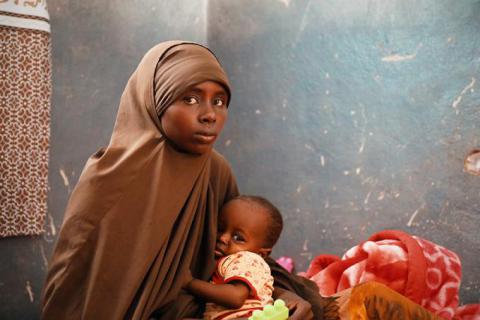Saving lives in drought affected regions of Ethiopia by Implementing Emergency Health and Nutrition activities - Abdia’s Story
Story by Seifu Asseged

Summary
Abdia, 20, a mother of two young girls – one and three years old – live in a remote rural village in the Somali Region of Ethiopia. Abdia is a pastoralist and lives a nomadic style of life where her family constantly moves in search of better pastures for her livestock. She was quite settled with her seven cattle, 50 goats and sheep, and two donkeys but in just five months, Abdia lost the majority of her animals. The prolonged drought affecting Ethiopia, and the greater Horn of Africa, has left her with just a few small ruminants in poor health - one donkey, less than 10 shoats and two heads of cattle.
Abdia is one of 500 families in a remote village of the Somali region where livestock rearing makes up the majority of livelihoods. The meat and dairy products are used not just as a source of income but also for household consumption. However, the delayed and failed rainy seasons of Gu and Dyer or long and short rains in the areas have resulted in Abdia, and millions of families, lose most of their livestock. Not only has her livestock not been able to have enough pasture and water but her family and two young toddlers have also been affected by the lack of food and water due to the debilitating drought. Deka*, her 1-year-old, was recently screened for severe malnutrition that required immediate treatment.
Abdia's story in her own words
“My name is Abdia, I am 20 years old and I have two young girls. One of them is Deka*, my one-year-old, who in the past few days, has not been feeling well.
She has been having diarrhoea, an upset stomach, and vomiting. She completely lost her appetite and became thin and weak.
At the time, I was very confused and did not know what to do. Although I wanted to take her to the clinic, I did not have enough money and I kept her home hoping that she will get better. However, instead of improving, her condition worsened, and she lost a lot of weight and started looking feeble. First, I took her to the traditional healer near our village, but Deka’s* health kept deteriorating. At this time, I met Save the Children who were in our village, giving away food supplements for children like Deka*. When they saw Deka*, they told me immediately to take her to the health centre, which I did.
To take Deka* to the clinic, I sold off two goats for ETB 2,000 (USD 38) and paid ETB 1,300 (USD 25) for the motorbike ride. Upon arrival, the medical staff immediately gave Deka* milk and medicines. At least 48 hours after continued treatments, her diarrhea subsided, and she stopped vomiting. She is recovering well.
Initially, I had no idea about the free health services at the health centre. Aside from the full treatment, Save the Children helped us by providing daily allowances of ETB 120 (USD 2.5). This helped us with our food and other daily basic costs. I cannot say thank you enough to the health workers for the support they provided us and for saving my daughter's life.
Before the drought, we used to own seven heads of cattle, two donkeys and more than 50 shoats. Now, we have lost most of them to the drought. We are only left with only one donkey, less than 10 shoats and two heads of cattle. Because of the current drought in the area, we are suffering from a shortage of water for ourselves and our animals.
Our biggest concern is the scarcity of food in the area. The food prices have continued to increase by the day, while the money we get from selling our livestock is diminishing at the same time. I am worried that if the situation does not improve, we will not be able to earn money, which means we cannot buy food, and eventually starve.
Livestock rearing is the only work that we know best and have been working on year after year. These days, the yield from the livestock is very small we have been living from hand to mouth. In the future, with the help of the government, we plan to engage in farming in addition to livestock rearing, so that this way we can improve our livelihoods and have an alternative source of income.”
Additional interviews:
“Unfortunately, situations like Abdia’s are not uncommon. Millions of people in Gode and other eastern regions of Ethiopia are heavily affected by drought. In Somali region alone, we have seen cumulative cases of severe malnutrition reach nearly 50,000 for children under five from January to April 2022. We are doing what we can, but we need more support because of the unprecedented number of people affected.” says Alinoor Mohamed, Humanitarian Response Manager at Save the Children Ethiopia’s East Area Office.
Project Background
What is Save the Children doing to help Abdia and others like her?
Since August 2021, Save the Children through funding from USAID’s Bureau of Humanitarian Assistance, has been implementing emergency health and nutrition activities as well as Infant and Young Child Feeding in Emergencies (IYCF-E) in four districts of Dawa zone in the Somali region in response to the prolonged drought. So far, a total of 77,000 children under the age of five and pregnant and lactating women have been screened for malnutrition. Around 13,947 children with severe acute malnutrition received treatment through the 77 health posts and 11 health centers supported by Save the Children in the remote villages. Meanwhile, around 1,053 children with medical complications have been referred to the government-run stabilization centres which Save the Children also supports through capacity building.
 Ethiopia
Ethiopia